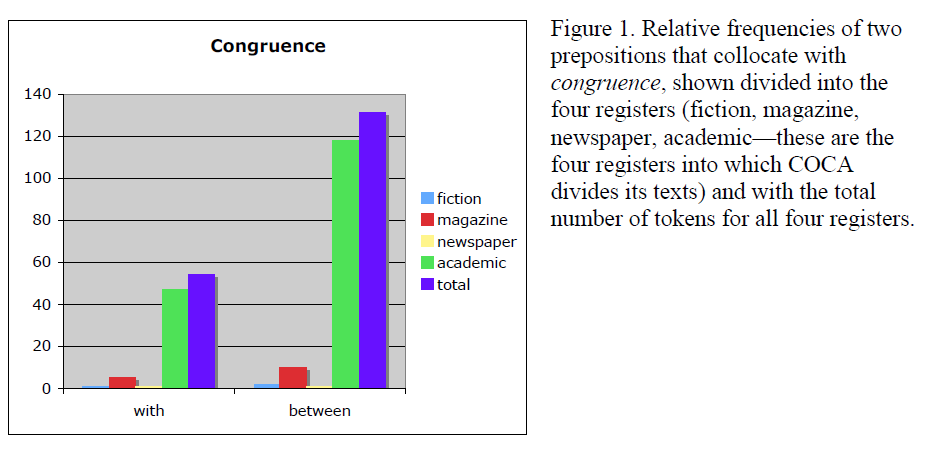Christina Champenois and Professor Doris Dant, Department of Linguistics and English Language
Merriam-Webster’s Collegiate Dictionary defines collocation as “a noticeable arrangement or conjoining of linguistic elements” (s.v. “collocation”). Collocational constructions may present difficulties to editors, translators, and second-language learners. Malgorzata Martyńska explains that collocations tend to be “one of the most problematic and error-generating area [sic] of vocabulary, especially for second language learners” (5) and that “collocations pose enormous
problems, even for the most proficient in English” (10). My research focuses specifically on noun-preposition collocations.
The specific noun-preposition collocations I consider in my study are taken from the 2010 Chicago Manual of Style (CMS). The CMS is one of the most conservative and widely used style manuals, which makes its guidelines ideal for a study comparing recommended usage to actual educated usage. Bryan A. Garner’s chapter on grammar and usage in the 2010 CMS includes a list of “words and the prepositions construed with them” (252–54). The list contains not only
verb-preposition collocations but also adjective-preposition and noun-preposition collocations. My study focuses on the fourteen nouns in the CMS list and the prepositions collocating with those nouns. The fourteen nouns are ban, blasphemy, cohesion, congruence, contemporary, dissent, excerpt, hegemony, impatience, mastery, predilection, pretext, sanction, and trust. Examples of noun-preposition collocations in the CMS list include trust in and trust for.
I compared the CMS guidelines to actual usage as per the Corpus of Contemporary American English (COCA). I used COCA because it is a monitor corpus, which means that it is regularly updated and therefore reflects current usage of words and collocations better than static corpora, which have no additional material added to them. COCA is searchable by parts of speech, making it ideal for finding information about noun-preposition collocations. Also, the CMS is for
American English and COCA focuses on American English materials.
To gather my data, I performed COCA searches for each of the fourteen nouns that appeared in these noun-preposition collocations and analyzed the results to determine (1) which prepositions collocate with each noun and (2) whether the noun-preposition collocations in COCA are used in the same meaning contexts described in the CMS guidelines. I found that some of the nouns had additional prepositions, other than those listed in the CMS, frequently collocating with them; that some of the meaning contexts included in the CMS guidelines only partially described the meaning contexts found for the noun-preposition collocations in COCA; and that some of the guidelines provided completely full and accurate descriptions of actual usage as per COCA.
An example of a noun from the CMS list that had an additional preposition frequently collocating with it is congruence. The CMS entry for congruence reads, “congruence (n.): with [a standard].” However, as can be seen in the figure below, the noun-preposition collocation congruence with occurs in 54 tokens on COCA, compared to 131 tokens of congruence between. Despite the second noun-preposition collocation’s appearing on COCA more than twice as frequently as the first, congruence between is not included in the CMS guideline.
According to my research, the CMS guidelines are generally good representations of the actual usage of the noun-preposition collocations in my study. For nine of the fourteen nouns in these collocations, I have suggested changes that would cause the guidelines to more closely reflect actual usage as per COCA. For the remaining five nouns and their collocating prepositions, the CMS guidelines already accurately represent actual usage as per COCA.
Limitations of my study include the fact that my study focuses only on actual usage as a basis for formulating usage guidelines. However, Garner has stated that “in the end, the actual usage of educated speakers and writers is the overarching criterion for correctness. But while actual usage can trump the other factors, it isn’t the only consideration” (xviii).
References
- The Chicago Manual of Style: The Essential Guide for Writers, Editors, and Publishers. 16th ed. Chicago and London: The University of Chicago Press, 2010.
- Garner, Bryan A. Garner’s Modern American Usage. 3rd ed. New York: Oxford University Press, 2009.
- Martyńska, Malgorzata. “Do English language learners know collocations?” Investigationes Linguisticae 11 (2004): 1–12.
- Merriam-Webster’s Collegiate Dictionary. 11th ed. Springfield, MA: Merriam-Webster, Inc., 2003.

